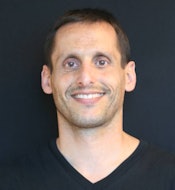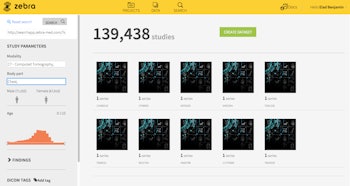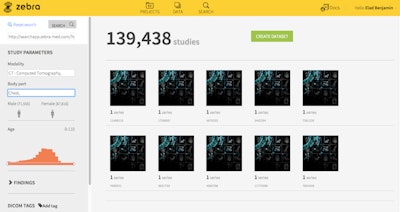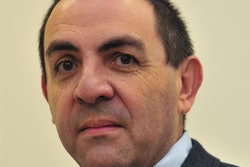
For Israeli image analysis software developer Zebra Medical Vision, size definitely matters. The start-up believes its database of 10 million curated imaging studies and extensive collaborations with researchers around the world will take image analysis algorithms to a whole new level.
In addition to its goal of producing higher-quality image analysis tools, Zebra also plans to pursue a different market. Instead of having algorithms used directly by radiologists in the traditional interpretation process, Zebra envisions that its offerings will be used offline by HMOs and accountable care organizations (ACOs) as large-scale clinical analysis and population management tools, said Zebra co-founder and CEO Elad Benjamin.
 Zebra Medical Vision CEO Elad Benjamin.
Zebra Medical Vision CEO Elad Benjamin.Benjamin is an imaging industry veteran who previously worked for PACS software developer Algotec and later Carestream Health as general manager of the company's Healthcare Information Solutions (HCIS) group.
"When you look at the financial dynamics in the U.S. today, there's a very strong incentive to flag risk early in the life cycle of a patient," Benjamin said. "The earlier you identify the disease and the earlier you treat it, usually the less cost it is for the system for most diseases."
The bionic radiologist
The idea for Zebra stemmed from co-founders Eyal Toledano and Eyal Gura, who have experience applying image analysis algorithms to compare photographs published on the Web with stock photography databases to determine if there's been any copyright infringement, Benjamin said. They sought to apply the same concept to healthcare.
"The vision is to create the bionic radiologist," he said. "That might sound a little threatening, but at the end of the day, we believe that the advances that have come along in computer vision and artificial intelligence allow us to create algorithms that are much, much better than what's been done before."
Image analysis algorithms are certainly not new in medical imaging. While a number of computer-aided detection (CAD) companies have come and gone and multiple firms offer algorithms today, the problem is that these CAD algorithms have typically been trained and developed on tens or at most a few hundred studies, Benjamin said.
"When that algorithm meets the real world, it starts falling apart," he said. "And so you have CAD companies that have too many false positives, which ultimately leads to a situation where the radiologists really don't use those tools."
Big data
Outside of healthcare, big-data analysis techniques have had a big impact recently on the field of image and pattern recognition. For example, big-data algorithms have evolved to the point where they can scan a picture of a city street view off the Internet and tell you everything that's in the picture, Benjamin said.
"The way that's been done is by feeding that algorithm millions and millions of images that are tagged, and the algorithm learns what a person looks like from different angles," he said. "The key is a lot of data. The more you feed the algorithm, the better it becomes because it needs hundreds of thousands of samples to create a model that it can follow."
It's been very hard in the past to access that volume of data in medical imaging. Even though hospitals have massive amounts of data in their archives, it's not available in such a way that's accessible for algorithmic research, Benjamin said.
However, Zebra has been able to stockpile a database of 10 million deidentified imaging studies from a variety of hospitals.
"It took two and a half years to curate, but then this became the infrastructure to say, OK, now we have the size and magnitude that's never been held before by anyone else, and now we can use these tools to actually create algorithms that are better than what was before," he said.
As an example, there are 900,000 CT studies in the database, including 400,000 chest CT scans, Benjamin said.
"If you look at algorithms today that do CT lung nodule detection, they've been tested on 100, 200 [studies]; we have 200,000 [studies]," he said. "So if you can create an algorithm with a low false-positive rate and it works on that vast amount of data, you've created something that will work in the real world as well, not just in the lab."
A black box
Zebra's grand vision is ultimately to create what could be thought of as a "black box, in which a study comes in and a diagnosis comes out," Benjamin said.
This black box would be built by developing hundreds of individual algorithms, each for applications such as identifying breast cancer on mammography, spotting a malignant lung nodule on lung CT, finding brain tumors on MRI, and finding pneumonia on a chest computed radiography (CR) study.
"Each one [of these applications] knows how to identify a specific pathology," he said. "Now when a study comes in, based on the parameters of that study, the relevant algorithms would be run on it to see whether the finding is there."


Zebra's Medical Imaging Research platform facilitates the development of individual image analysis algorithms targeted at specific indications. Image courtesy of Elad Benjamin.
Because Zebra can't build all of these applications on its own, the company plans to enlist researchers from around the world. In early April, it debuted a closed beta version of its cloud-based Medical Imaging Research platform, which provides access to Zebra's large database of studies, as well as storage, graphics processing unit (GPU) computing power, and support for a variety of research tools, according to the firm.
"On one platform, we have a mechanism that allows you both to develop an algorithm and test it against a database and data that you can't get anywhere else," he said. "The hope is that by bringing high-end research groups online, we can accelerate the pace and quality of the algorithms that come out."
About 50 research teams from academic institutions around the world have expressed interest in participating, Benjamin said. Once algorithms are commercialized, Zebra will share revenue for each algorithm with the researchers who developed it, he said.
An in-house Zebra development team is also working on an initial algorithm that is expected to have a pilot launch in the next few months. After receipt of U.S. Food and Drug Administration (FDA) 510(k) clearance, Zebra hopes to have the first algorithm ready for commercial use early next year.
Via the pipeline of algorithms being developed, Zebra hopes then to be able to add new algorithms every few months, Benjamin said. A number of HMOs and ACOs in the U.S. have already expressed interest in Zebra's planned offering.
The company's commercialization plans also recently received a boost with the completion of an $8 million funding round led by Khosla Ventures, along with Deep Fork Capital and Salesforce CEO Marc Benioff.




















